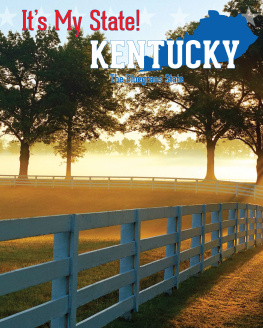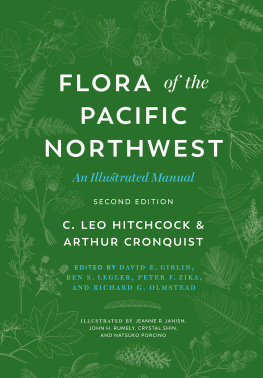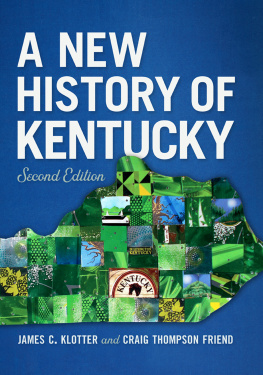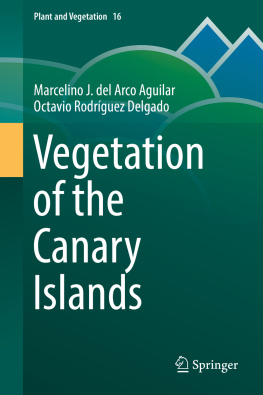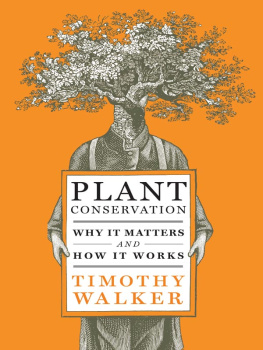PLANT LIFE OF KENTUCKY
We had passed through a great forest, on which stood myriads of trees, some gay with blossoms, others rich with fruits. Nature was here a series of wonders, and a fund of delight. Here she displayed her ingenuity and industry in a variety of flowers and fruits, beautifully coloured, elegantly shaped, and charmingly flavoured; and we were diverted with innumerable animals presenting themselves perpetually to our view.
DANIEL BOONE, 1769 (AS PUBLISHED IN FILSON 1784)
It is extremely unfortunate that in a state endowed by nature with so inspiring a topographical panorama, where mountains and hill land contrast so pleasingly with rolling plateau and barren, and where originally beneath magnificent, broad-leaved forests along mountain stream and meadow brook, there existed abundant and varied wild life, that such wretched physical conditions as are now only too apparent have come to exist.
W. R. JILLSON, 1924 (AS PUBLISHED IN PRIMEVAL TRACTS OF KENTUCKY)
PLANT LIFE OF KENTUCKY
AN ILLUSTRATED GUIDE TO THE VASCULAR FLORA

RONALD L. JONES
WITH THE ASSISTANCE OF
JOHN W. THIERET, EDITORIAL ASSOCIATE
AND
CHARLES J. LAPHAM, TECHNICAL ASSOCIATE

Publication of this volume was made possible in part by a grant from the National Endowment for Humanities.
Copyright 2005 by The University Press of Kentucky
Scholarly publisher for the Commonwealth, serving Bellarmine University, Berea College, Centre College of Kentucky, Eastern Kentucky University, The Filson Historical Society, Georgetown College, Kentucky Historical Society, Kentucky State University, Morehead State University, Murray State University, Northern Kentucky University, Transylvania University, University of Kentucky, University of Louisville, and Western Kentucky University.
All rights reserved.
Editorial and Sales Offices: The University Press of Kentucky
663 South Limestone Street, Lexington, Kentucky 40508-4008
www.kentuckypress.com
09 08 07 06 05 5 4 3 2 1
Library of Congress Cataloging-in-Publication Data
Jones, Ronald L. (Ronald Lee)
Plant life of Kentucky : an illustrated guide to the vascular flora / Ronald L. Jones.
p. cm.
Includes bibliographical references and index.
ISBN 0-8131-2331-3 (hardcover : alk. paper)
1. BotanyKentucky. 2. PlantsIdentification. I. Title.
QK162.J66 2005
581.9769dc22 2004026889
This book is printed on acid-free recycled paper meeting
the requirements of the American National Standard
for Permanence in Paper for Printed Library Materials.

Manufactured in the United States of America.

| Member of the Association of
American University Presses |
DEDICATION
TO MY WIFE, KATHLEEN, MY DAUGHTER, REBECCA, AND MY SON, ANDREW, FOR ALL THEIR LOVE, SUPPORT, AND ENCOURAGEMENT.
AND TO THE LOVING MEMORY OF MY PARENTS, HERMAN L. JONES (19201998) AND FLORA A. JONES (19252000).
THE FINANCIAL SUPPORT OF THE FOLLOWING CONTRIBUTORS IS GRATEFULLY ACKNOWLEDGED:

THE KENTUCKY DEPARTMENT OF FISH AND WILDLIFE RESOURCES
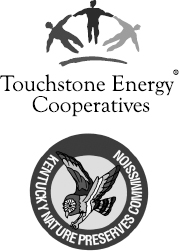
KENTUCKY STATE NATURE PRESERVES COMMISSION

EASTERN KENTUCKY UNIVERSITY,
DIVISION OF NATURAL AREAS

THE KENTUCKY NATIVE PLANT SOCIETY
ACKNOWLEDGMENTS
I thank John W. Thieret of Northern Kentucky University for his careful editing of the entire manuscript and his continued encouragement throughout the many drafts of this book; Charles J. Lapham for his technical assistance in obtaining the scanned images from the 1913 edition of Britton & Brown (see Credits), and arranging the images into an easily accessible, digital format; Pam Bowlin for her dedicated work in the layout of these images and the text into Pagemaker files; and the staff of the University Press of Kentucky and Shepherd, Inc. for their expert help in getting the manuscript into final form for publication.
As of this writing I have been a faculty member at Eastern Kentucky University for 23 years, and must express my gratitude for the universitys continued administrative support of the EKU Herbarium and of my research activities. Without this support, this book would not have been possible.
The following botanists generously contributed treatments: Robert W. Freckmann of the University of Wisconsin, Stevens Point (Dichanthelium and Panicum); Landon McKinney of Environmental Quality Management, Inc. (Carex and Viola); John W. Thieret of Northern Kentucky University (Poaceae); and Timothy J. Weckman of Eastern Kentucky University (Viburnum). Robert Paratley of the University of Kentucky, David D. Taylor of the U.S. Forest Service, and Ralph L. Thompson of Berea College reviewed the entire book and provided many helpful corrections, comments, and suggestions.
Critical reviews by a number of individuals greatly enhanced the accuracy and readability of the text. Reviewers of the following sections are gratefully acknowledged: Introductory sections (Ross C. Clark, Marc Evans, William H. Martin, and Deborah White); Vegetation (William S. Bryant); History of Plant Life (Kelli Carmean, Mark F. Sweet, R.Thomas Lierman, and Stephen F. Greb); Floristic History (Patricia Haragan, Willem Meijer); Fabaceae (Ralph L. Thompson); Carex (Robert F.C. Naczi); Cyperus (Richard Carter); Gratiola (Dwayne Estes); and Vitaceae (David D. Taylor).
Many undergraduate student workers and graduate assistants helped in the typing of the manuscript and in providing research assistance during this project. Their involvement was indispensable.
The work of the many collectors who have labored over the last two centuries to collect, identify, label, and process herbarium specimens must also be recognized. The primary sources of these collections have been college and university faculty, undergraduate and graduate students working on floristic projects or theses, and public agencies. Some private organizations and individuals have also made significant contributions. Historically, faculty members at colleges and universitiesfrom Rafinesque and Short, to McFarland and Davies, to current curatorshave received little restitution or appreciation for their curatorial duties, but their contributions to our knowledge of the flora have been enormous and have provided the foundation upon which this work is built.
I would also like to acknowledge with appreciation the three individuals from whom I obtained most of my botanical trainingJohn E. Breeden, David Lipscomb University; E. Wayne Chester, Austin Peay State University; and Robert Kral, Vanderbilt University.
Next page







